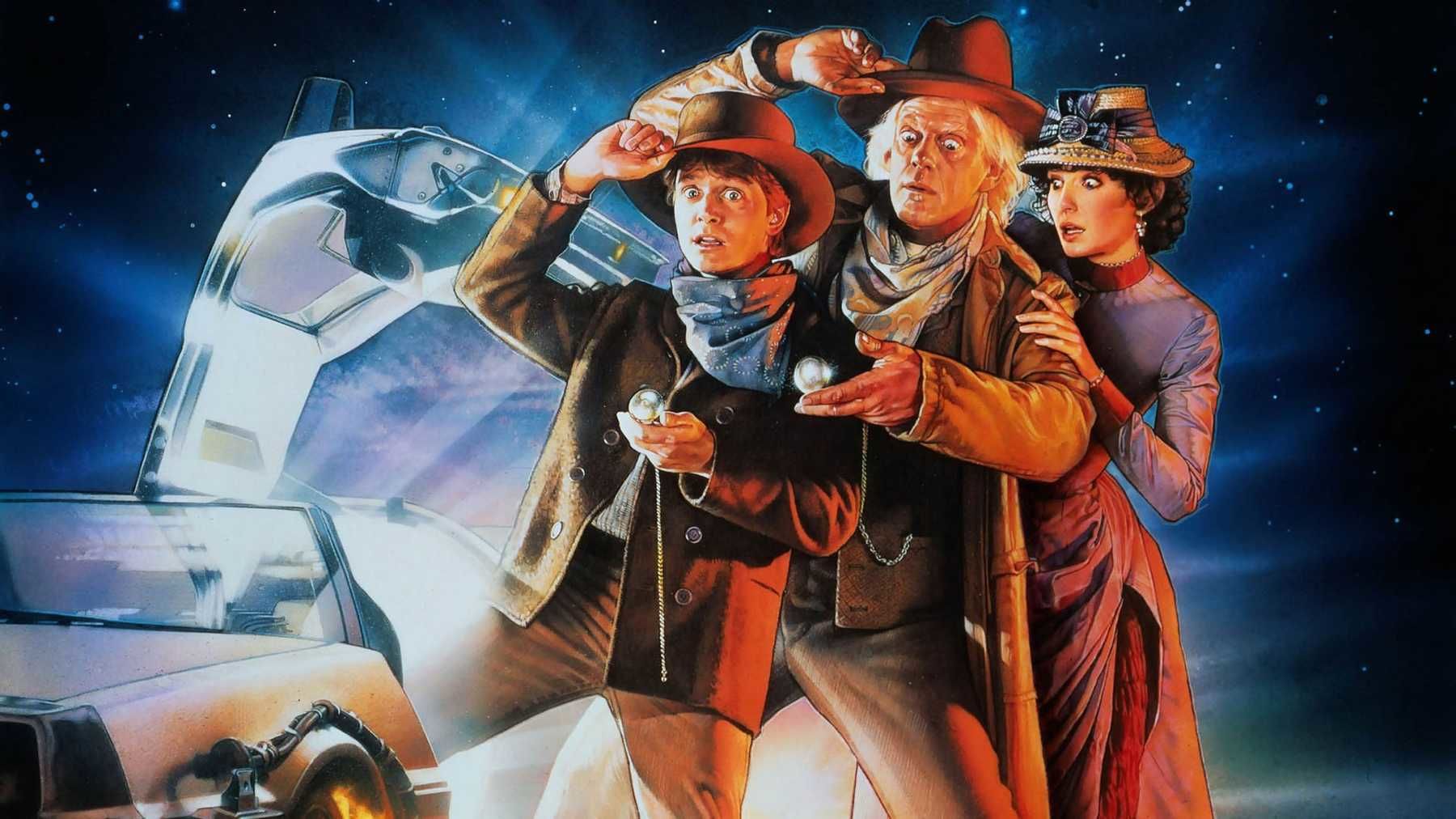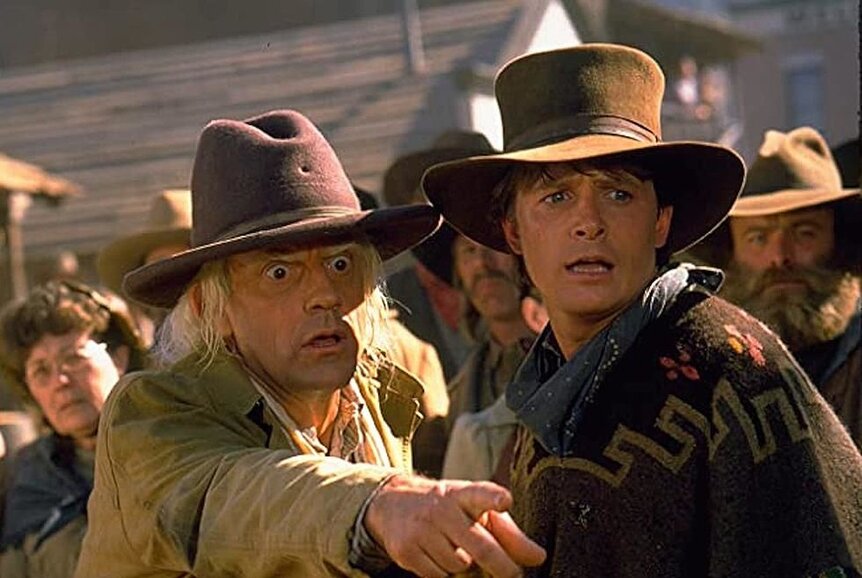Create a free profile to get unlimited access to exclusive videos, sweepstakes, and more!
Back to the Future Part III is actually the best sequel in the franchise

Back to the Future Part III gets a bum rap.
While the finer points of its narrative were lost on younger audiences when it first came out 30 years ago this week, a recent rewatch in honor of its 30th anniversary reveals it’s arguably the best sequel in the popular series. (Sorry not sorry, Back to the Future Part II.)
The final chapter in Robert Zemeckis and Bob Gale’s classic time-travel movie trilogy is (no pun intended) a Swiss watch of a script. The engaging story, set in the Wild West, clicks into place like safe tumblers as its intricate structure, brimming with callbacks to key moments and payoffs to events in the first film, finds Marty McFly (Michael J. Fox) once again going back to the past in order to ensure his future. Upon initial release, reaction to Part III was somewhat muted and mixed — especially coming off the hoverboard-filled (and more convoluted) box-office hit Back to the Future Part II.
While fans have obviously devoted significantly more care space to the first two installments, it’s Part III that comes closest, tonally, to matching and building upon the escapist, summer movie feel of the original 1985 adventure. It’s understandable why legions of fans have revisited the first two films in the Back to the Future trilogy more often over the years, but that doesn’t mean you should sleep on this underrated threequel.
Back to the Future Part III literally picks up where the previous installment left off. An alternate Marty surprises the s*** out of the original film’s 1955-based Doc Brown (Christopher Lloyd) — moments after Doc just sent the original Marty back to 1985. After Marty informs Doc he’s come back from the future — one where an evil Biff and self-lacing sneakers reign. From here, Part III hits the ground at 88 mph with a straightforward story that reaches back into 1885 Hill Valley for one last, epic flex of the flux capacitor.
Marty’s mission: Find Doc Brown and save him from being “shot in the back over a matter of $80” by Biff’s grandfather, Buford “Mad Dog” Tannen (played by the OG Biff, Tom Wilson). Romance ensues as well, this time for Doc, as Marty comes from 1955 with word of Clara (Mary Steenburgen), a woman Doc hasn’t met yet but, when he does, she will become his true love. The movie that ensues is the love child of what would happen if Zemeckis had a threeway with John Ford’s Stagecoach and H.G. Wells.
Streamlined and engrossing, thanks in part to being at ground level with these two effortlessly likable main characters, Part III seems to be a direct response to the criticism that BTTF II was too convoluted for its own good. (Even though these sequels were shot back to back). In fact, BTTF II seemingly dined out on finding new ways to entrap Marty in a series of complex paradoxes involving events of the first film, just so Zemeckis could show off his then-new motion capture and VFX techniques. (The filmmaker has a signature penchant for re-inserting figures into historical events, as he explored with much acclaim in 1994’s Forrest Gump.)
Less gimmicky than its predecessor, Back to the Future Part III doubles down on the beating heart of the series, the relationship between Marty and Doc, and gives them satisfying, emotional arcs that tug on the heartstrings in the film’s final moments. Whereas the first two movies were largely Marty stories, Doc takes center stage here. (Doc’s happy ending, where he goes from an eccentric man out of time to one who finally finds where he belongs — in a distant, simpler past he always admired but was born far too late to live in — is truly inspired.)
The film also closes the time travelers’ loop and literally smashes any hopes audiences have of seeing them break the laws of physics ever again when a train in 1985 crashes into the DeLorean. The time machine that could once fly is now scrap metal. A terrible, burdensome privilege reduced to junk. They leave the door open a crack, however, when Doc, Clara, and their family show up in Doc’s latest invention: a time-traveling locomotive. Even with the hint of more potential adventures in their future, the audience feels satisfied leaving it at this one.
It feels like a definitive ending because each character has come to the end of the story they started on thanks to Zemeckis and Gale’s commitment to character-first genre storytelling. This time around, the big emotional stakes are more personal than those of Part II, hovering near the level of those that drove Marty in BTTF. BTTF III’s nods to previous benchmarks in the series, like Marty waking from a “bad dream” to find himself being tended by his mom or her ancestor, or encountering Biff and his goons at a public establishment, they’re more than mere nostalgic needle drops. They are integral beats that underscore how far Marty and Doc have gone, even if their newest adventures subtly echo and reframe key moments from previous ones.
ZZ Top’s anachronistic cameo notwithstanding, Back to the Future Part III mostly holds up, thanks to the timelessness of its predominant Western setting and the charming dynamic of its main characters. You can tell Zemeckis and his collaborator, Gale, are as big a fan of westerns as they are of science fiction, especially with their dialogue. Take the scene where Marshall Strickland — an ancestor to Marty’s future high school principal and disciplinarian — faces off against Mad Dog and his posse at the entrance to a soiree. After using his scattergun to force Tannen to relinquish all his firearms before joining the party, Strickland drawls out: “Only party I’ll be smiling at is the one that sees you at the end of a rope.” Both the line and delivery feel like they could be in a classic John Wayne or Clint Eastwood western.
But only Back to the Future Part III could mesh the two genres of western and sci-fi together in a way that gives both two of their best entries. The franchise has always been both science fiction and a period piece, but it was a gamble in 1990 to ditch the former and make the movie a full-throated western. That is a tricky feat to pull off, and the filmmakers and cast make it seem effortless.
It’s not the stone-cold modern classic BTTF is, or the staple of online fandom that BTTF II became. But BTTF III is that rare threequel that sticks the landing in such a satisfying and rewarding way that, 30 years later, still holds up.
The views and opinions expressed in this article are the author's, and do not necessarily reflect those of SYFY WIRE, SYFY, or NBCUniversal.



























